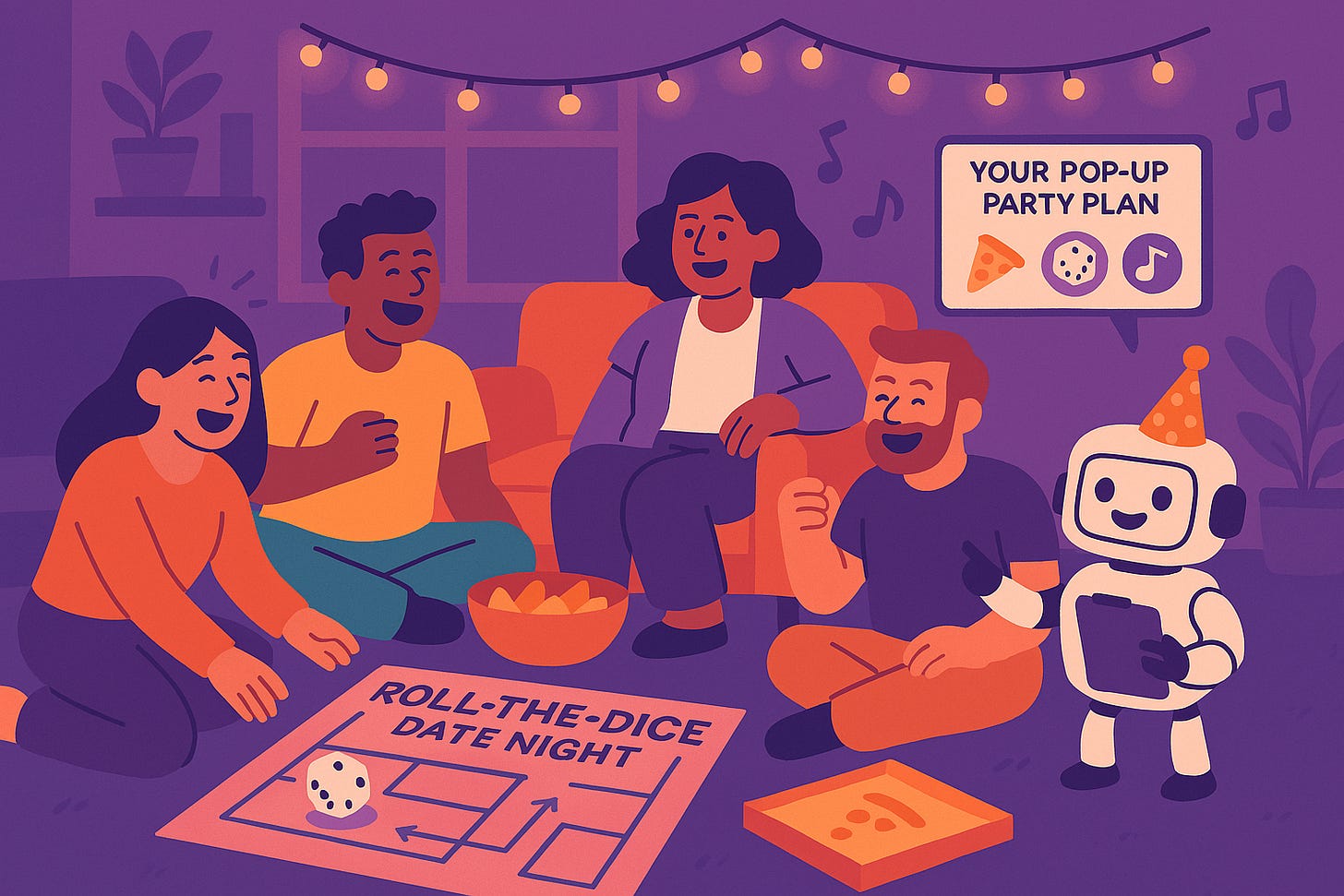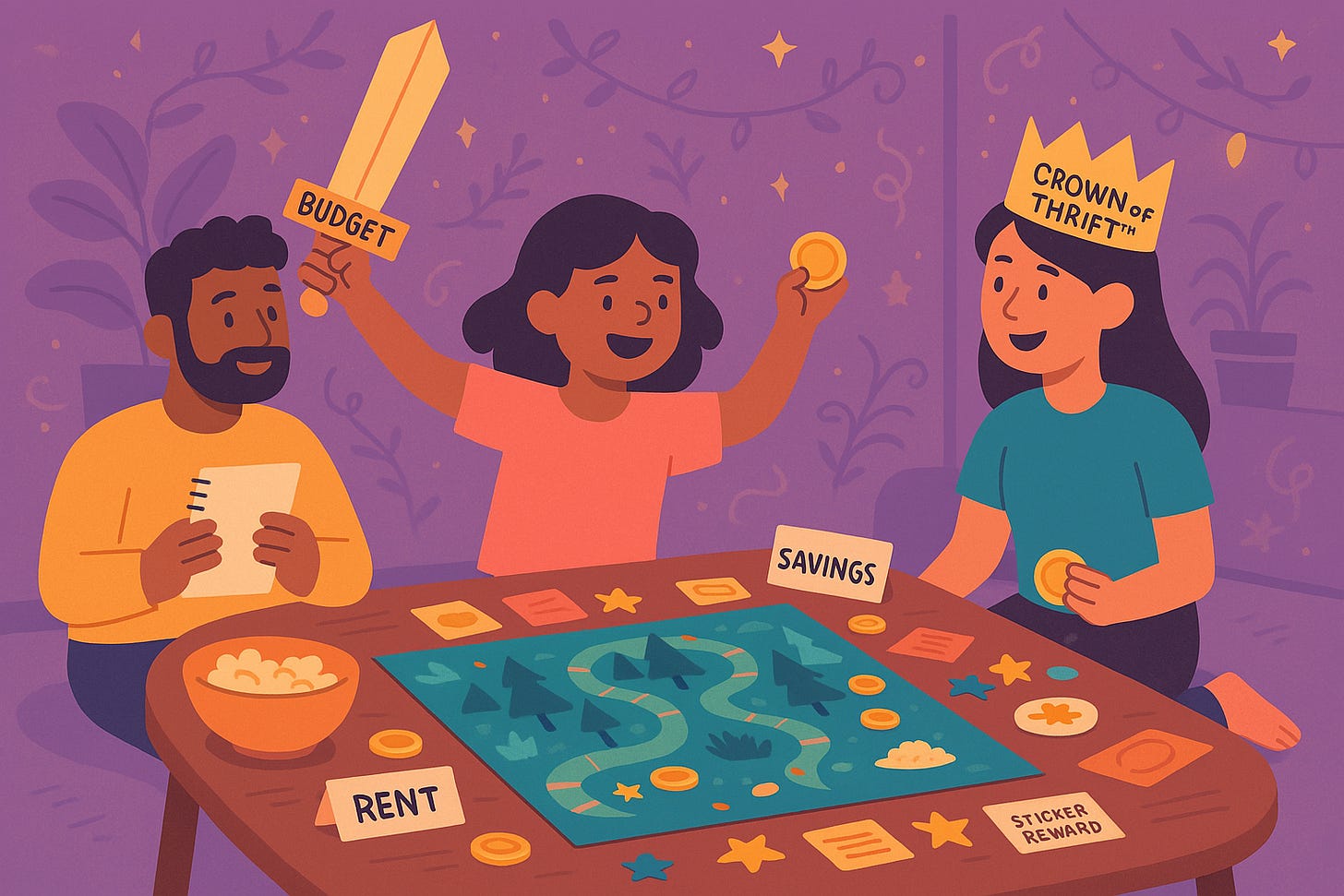AI Budget Hacks: Make Saving Money Creative and Fun
Easy ways to use AI prompts for fun budgeting ideas, low cost home entertainment, and everyday savings tips.
First time here? This article might help:
Budgeting has a bad reputation - all charts, rules, and the sneaky sense that fun’s off-limits until further notice. No wonder it feels like punishment wrapped in a spreadsheet.
But here’s the thing: you don’t have to be broke and bored. You can be creative, thrifty, and still have a good time — even a great one.
What if saving money felt less like restriction… and more like party planning? What if your co-planner never ran out of ideas, didn’t care about price tags, and didn’t judge you for eating nachos in a pillow fort? Even better? Most of these ideas cost next to nothing — because your living room should be a playground, not a financial trap.
That’s where AI comes in. Not as a financial advisor or budgeting app — but as your brainstorming buddy, your co-creator, your personal idea factory. This isn’t about sacrifice. It’s about clever, joyful ways to stretch your budget without shrinking your life.
Turn Your Home Into a Pop-Up Party — With AI as Your Creative Director
“Game night” sounds fun… until it’s just the same board game, the same snacks, and someone pretending they didn’t cheat last time.
But what if, instead of recycling the usual plans, you turned your home into a pop-up experience — something themed, playful, and just different enough to feel like a break from the ordinary?
That’s where AI can help. You give it the mood or idea — and it gives you a plan, a plot, and maybe even a playlist.
Try these:
Escape Room at Home
Prompt: “Design a printable at-home escape room using stuff I already have, for 3 adults and 2 kids. Keep it under $30.”
AI can map out puzzles, hide clues in your furniture, and turn a Saturday night into a low-stakes thrill ride - all without paying for tickets or a babysitter.Murder Mystery Dinner on a Dime
Prompt: “Write a one-hour murder mystery set in a 1980s mall food court. Include character cards, clues, and budget-friendly costume ideas.”
It’s cheesy. It’s ridiculous. And somehow… kind of delightful. (Bonus points if someone wears a fanny pack.)Roll-the-Dice Date Night Generator
Prompt: “Invent a ‘roll-the-dice’ date night generator with random meals, drinks, and games - all under $20 total.”
Let AI create a little chaos with pantry-based dinner options, goofy challenges, and unpredictable fun that costs less than one takeout order.Budget Travel Vibes
Prompt: “Plan a 'Pretend You're in Greece' night with budget meal ideas, Greek trivia, and background playlist suggestions. Max budget: $25.”
You’re not going anywhere, but your tastebuds and budget won’t know the difference. (Optional: wear a toga. On second thought, highly optional.)
The goal isn’t perfection — it’s novelty. When you use AI to co-create the vibe, a little effort goes a long way. None of this has to break the bank — in fact, the challenge of doing it within your budget is part of the fun. Let AI help you throw a party your wallet will still respect in the morning. And with the right prompt, even your living room can feel like a whole new world.
Ready to take it a step further? AI can also help you sneak in some financial know-how without killing the vibe.
Sneaky Money Lessons — Use AI to Build Engaging (and Weirdly Effective) Budgeting Games for Everyone
A lot of us didn’t grow up learning how money actually works. Maybe we learned to write a check in high school (remember those?), picked up a few tips here and there, and then got dropped into adult life with rent, taxes, and retirement plans no one explained.
Financial education can feel intimidating. Or boring. Or worse … both. But it doesn’t have to be. With a little help from AI, you can turn money lessons into bite-sized games, roleplays, and challenges that stick in your brain way better than a lecture ever could.
Whether you’re raising kids, helping a parent, or just trying to finally understand what a 401(k) actually is, these ideas are for you:
Financial Fantasy Quests
Prompt: “Create a 3-level roleplaying game where the hero learns to manage a budget while running a bakery in a magical forest.”
It’s part Dungeons & Dragons, part personal finance, and somehow it works.Simulated Allowance Challenge
Prompt: “Write a weekly allowance challenge where participants earn and spend money in a simulated family economy. Include choices, rewards, and consequences.”
You can run this with your kids — or your roommates. No judgment.DIY Shark Tank
Prompt: “Create a family-friendly version of Shark Tank where people pitch business ideas (like a lemonade stand), and someone plays the investor. Include fake budgets and a judging rubric.”
Great for siblings, neighbors, or a particularly competitive Sunday brunch.Spending Freeze Game
Prompt: “Create a month-long family game where everyone gets a fictional budget and earns points for real-life choices (like skipping takeout or using coupons). Add silly bonus rounds.”
Skipping your coffee run hits different when you're battling for the glittery (possibly homemade) Crown of Thrift™.
The point isn’t to get perfect at personal finance overnight. It’s to get comfortable thinking about it, talking about it, and making it a part of your everyday life — without zoning out or feeling judged.
AI won’t make your financial decisions for you. But it can help you learn more, faster — and with a lot more fun along the way.
Low-Key Budget Wins — Everyday Prompts to Stretch Your Dollar Without Feeling Deprived
Sometimes budgeting just feels like one long chain of “nope”: No to coffee runs, no to takeout, no to anything fun.
But the real magic of saving money isn’t in saying no — it’s in spotting the smarter yes. And with AI in your corner, you can make those yeses feel like tiny wins instead of compromises.
Try asking:
“Give me five ‘treat yourself’ ideas under $20 each that don’t feel cheap.”
You’d be surprised how many joy-sparking things fit in a ten-dollar bill — and no, they don’t all involve bubble baths (unless that’s your thing).“Plan a week of meals where no recipe costs more than $2 per serving.”
AI can help you get creative with pantry staples, reduce food waste, and still keep dinner interesting — even on tight budgets.“What’s a fun reward system I can use to hit my savings goals?”
Because sometimes we need more than a sense of accomplishment. Sometimes we need stickers. Or tacos. Or a gold star next to “Didn’t impulse-buy a kayak.”“Create a one-week stay-at-home challenge with $0 activities each day.”
Turn a quiet week into something that feels like a game — scavenger hunts, theme nights, zero-dollar self-care. AI’s got ideas, and most of them don’t involve downloading another app.
The goal here isn’t frugality for its own sake. It’s building a life where spending with intention actually feels better than splurging out of boredom or stress.
The right prompt flips the question from “What should I cut?” to “What can I create?”
And that’s where real freedom starts to show up.
Conclusion
Budgeting doesn’t have to be bleak. It can be creative. Surprising. Even… kind of fun. Especially when you have tools that work with your values instead of against your joy.
AI isn’t here to tell you what to spend or how to save. But it is a pretty great idea machine — one that never gets tired of brainstorming, customizing, and remixing ways to make your money go further.
So try a prompt. See what happens. You might start a new family tradition, save a few bucks, or just make Wednesday night feel less like…Wednesday night.
If any of this works for you, drop a comment and let me know — or share this with a friend who could use a win without the price tag.





